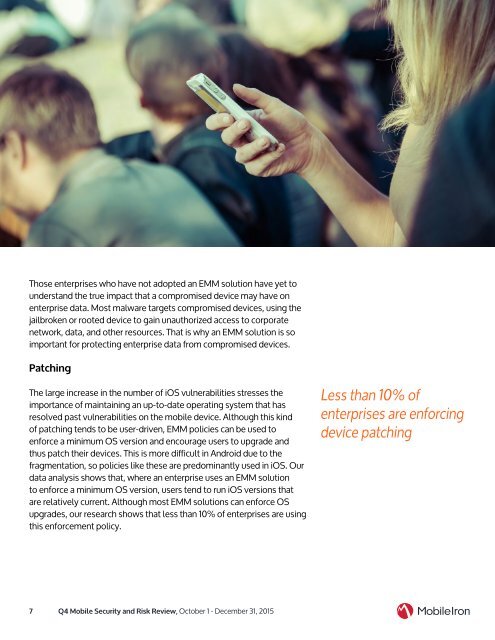Q4 Mobile Security and Risk Review
security-report-Q415-v1.2-EN
security-report-Q415-v1.2-EN
You also want an ePaper? Increase the reach of your titles
YUMPU automatically turns print PDFs into web optimized ePapers that Google loves.
Those enterprises who have not adopted an EMM solution have yet to<br />
underst<strong>and</strong> the true impact that a compromised device may have on<br />
enterprise data. Most malware targets compromised devices, using the<br />
jailbroken or rooted device to gain unauthorized access to corporate<br />
network, data, <strong>and</strong> other resources. That is why an EMM solution is so<br />
important for protecting enterprise data from compromised devices.<br />
Patching<br />
The large increase in the number of iOS vulnerabilities stresses the<br />
importance of maintaining an up-to-date operating system that has<br />
resolved past vulnerabilities on the mobile device. Although this kind<br />
of patching tends to be user-driven, EMM policies can be used to<br />
enforce a minimum OS version <strong>and</strong> encourage users to upgrade <strong>and</strong><br />
thus patch their devices. This is more difficult in Android due to the<br />
fragmentation, so policies like these are predominantly used in iOS. Our<br />
data analysis shows that, where an enterprise uses an EMM solution<br />
to enforce a minimum OS version, users tend to run iOS versions that<br />
are relatively current. Although most EMM solutions can enforce OS<br />
upgrades, our research shows that less than 10% of enterprises are using<br />
this enforcement policy.<br />
Less than 10% of<br />
enterprises are enforcing<br />
device patching<br />
7 <strong>Q4</strong> <strong>Mobile</strong> <strong>Security</strong> <strong>and</strong> <strong>Risk</strong> <strong>Review</strong>, October 1 - December 31, 2015






